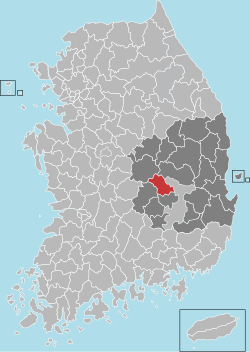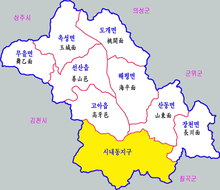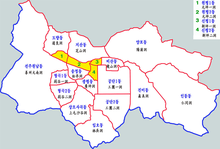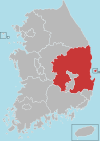Gumi, North Gyeongsang
Gumi
구미시 | |
|---|---|
Municipal City | |
| Korean transcription(s) | |
| • Hangul | 구미시 |
| • Hanja | 龜尾市 |
| • Revised Romanization | Gumi-si |
| • McCune-Reischauer | Kumi-si |
 Gumi city hall | |
 Flag Emblem of Gumi | |
 Location in South Korea | |
| Country | |
| Region | Yeongnam |
| Administrative divisions | 3 eup, 5 myeon, 17 dong |
| Area | |
| • Total | 616.25 km2 (237.94 sq mi) |
| Population (February 2019) | |
| • Total | 427,770 (KOSIS: Ministry of Public Administration and Security status of resident registration population) |
| • Density | 552.5/km2 (1,431/sq mi) |
| • Dialect | Gyeongsang |
Gumi (Korean: 구미; Korean pronunciation: [ku.mi]) is the second largest city in Gyeongsangbuk-do, South Korea. It is located on the Nakdong River, halfway between Daegu and Gimcheon, also lies on the Gyeongbu Expressway and Gyeongbu Line railway which are the principal traffic routes of the country.
The city is an industrial center of the country with many companies, including Samsung Electronics and LG Display, having a manufacturing presence there. The primary industries are electronics, textiles, fibers, rubber, plastic and metal products. In Gumi, 1,772 companies employ over 80,000 workers.[1] It is the largest scale in Korea. In 2009, the city exported the largest amount in the country and accounted for 96.9% of trade surplus of Korea in 2000 to 2009.[2]
The former President of South Korea, Park Chung-hee, was born in the city.
History[]
In the Three Kingdoms period, Gumi was part of the territory of the Silla Kingdom. The first Silla temple, , was constructed here.
More recently, the town was the birthplace of the South Korean president Park Chung-Hee. Not coincidentally, it was during his administration that the South Korean government selected Gumi as a site for major industrial development. His birth home is a museum today.
Gumi developed rapidly during the 1960s, growing from a small rural town into a large city thanks to huge infusions of development money from the government. It was selected for development for some practical reasons such as its easy access to transportation infrastructure, and its location in the industrialized Yeongnam region.
Administrative divisions[]
The city center of Gumi is divided into 17 dong, or neighborhood units. The hinterland is divided into 5 myeon, or rural areas, and 3 eup, or large villages. Sandong was promoted from a myeon to a eup on 1 January 2021.


| Name | Hangeul | Hanguk |
|---|---|---|
| Seonsan-eup | 선산읍 | 善山邑 |
| Goa-eup | 고아읍 | 高牙邑 |
| Sandong-eup | 산동읍 | 山東邑 |
| Mueul-myeon | 무을면 | 舞乙面 |
| Okseong-myeon | 옥성면 | 玉城面 |
| Dogae-myeon | 도개면 | 桃開面 |
| Haepyeong-myeon | 해평면 | 海平面 |
| Jangcheon-myeon | 장천면 | 長川面 |
| Songjeong-dong | 송정동 | 松亭洞 |
| Wonpyeong-dong | 원평동 | 元坪洞 |
| Doryang-dong | 도량동 | 道良洞 |
| Jisan-dong | 지산동 | 芝山洞 |
| Seongjuwonnam-dong | 선주원남동 | 善州元南洞 |
| Hyeonggok 1(il)-dong | 형곡1동 | 荊谷一洞 |
| Hyeonggok 2(i)-dong | 형곡2동 | 荊谷二洞 |
| Sinpyeong 1(il)-dong | 신평1동 | 新坪一洞 |
| Sinpyeong 2(i)-dong | 신평2동 | 新坪二洞 |
| Bisan-dong | 비산동 | 飛山洞 |
| Gongdan-dong | 공단동 | 工團洞 |
| Gwangpyeong-dong | 광평동 | 廣坪洞 |
| Sangmosagok-dong | 상모사곡동 | 上毛沙谷洞 |
| Imo-dong | 임오동 | 林烏洞 |
| Indong-dong | 인동동 | 仁同洞 |
| Jinmi-dong | 진미동 | 眞美洞 |
| Yangpo-dong | 양포동 | 陽浦洞 |
People[]
- Former South Korean president Park Chung-hee
- Former South Korean president Park Geun-hye - daughter of Park Chung-hee
- Singer and I Am A Singer 4 finalist Hwang Chi-yeul
- Singer and H.O.T. member Jang Woo-hyuk,
- Singer and g.o.d member Kim Tae-woo
- e-sports player Lee Yun-Yeol-known as "Genius Terran"
- Girl group member Kim Chanmi from AOA
- Kim Hyo Suk - the first person in South Korea to obtain a doctoral degree in Art Therapy.[3]
Population: At present, the population of Gumi is 427,770 (as of February 19, 2019).[4]
Sport[]
Gumi was the homeground of the KB Insurance Stars volleyball team until July 2017, when the club relocated to Uijeongbu.[5] The team played at the Park Chung-hee Gymnasium.
Geumo Mountain[]


Geumo Mountain (Geumo San) Provincial Park is a hiking destination. The peak at 976 m above sea level is one of the eight famous spots in the Yeongman area and is the location of the start of the nature preservation campaign in Korea. The park has an amusement area called Geumo Land and the Geumo reservoir. There are several interesting sites on the mountain that include:[6]
Doesan Cave named after the Buddhist monk Doesan who attained a state of nirvana in the cave. He was a master of the theory of "divination based on topography" in the later Shilla dynasty.
Daehye Waterfall is 27 m high and is especially full during the rainy season. It can be completely dry during periods without rain and is frozen in winter.
The HaeUn Buddhist Temple is also near the top of the cable car route.
The Doesan Cave, Daehye Waterfall and HaeUn Buddhist Temple are easily reached by taking the cable car from the entrance of the park and then hiking a short distance.
The YakSa Temple is an active Buddhist temple and is said to have been created to commemorate Saint Ulsang's attainment of nirvana. It is sited near the top of the mountain and can be reached both from the peak and by a trail from the bottom. It has a unique bell that sits on a separate spike of rock connected by a suspension bridge.
The Ma Ae Cliff Buddha (National Treasure #490) is carved into the corner of a cliff face and is thought to have been created during the Goryeo dynasty.
The YakSa Temple and the Ma Ae cliff Buddha statue are both near the summit of Geumo Mountain and require about one to two hours of hiking to reach them.
Industrial accident[]
On September 27, 2012 workers at the Hube Global[7] plant in Gumi were unloading hydrofluoric acid (HF) from a tanker when an explosion occurred causing about 8 tonnes of the acid to leak into the surrounding area. The leak caused 5 deaths initially and prompted more than 3000[8] people to seek medical attention at local hospitals. Local rice and grape crops were ruined because the acid caused them to wither. Approximately 3,200 livestock were exposed. The acid, which can etch glass and is used in the electronics industry, caused damage to at least 1,000 vehicles. Total damage costs as of October 10, 2012 were about 16 million USD.[9]
Climate[]
| hideClimate data for Gumi (1981–2010) | |||||||||||||
|---|---|---|---|---|---|---|---|---|---|---|---|---|---|
| Month | Jan | Feb | Mar | Apr | May | Jun | Jul | Aug | Sep | Oct | Nov | Dec | Year |
| Record high °C (°F) | 20.8 (69.4) |
22.2 (72.0) |
29.6 (85.3) |
34.4 (93.9) |
36.9 (98.4) |
43.2 (109.8) |
44.5 (112.1) |
44.9 (112.8) |
37.3 (99.1) |
30.6 (87.1) |
28.5 (83.3) |
23.0 (73.4) |
44.9 (112.8) |
| Average high °C (°F) | 4.3 (39.7) |
7.2 (45.0) |
12.7 (54.9) |
20.2 (68.4) |
24.9 (76.8) |
27.9 (82.2) |
29.8 (85.6) |
30.4 (86.7) |
26.2 (79.2) |
21.1 (70.0) |
13.5 (56.3) |
6.9 (44.4) |
18.7 (65.7) |
| Daily mean °C (°F) | −1.3 (29.7) |
1.1 (34.0) |
6.2 (43.2) |
12.9 (55.2) |
18.0 (64.4) |
22.1 (71.8) |
24.9 (76.8) |
25.2 (77.4) |
20.1 (68.2) |
13.6 (56.5) |
6.8 (44.2) |
0.8 (33.4) |
12.5 (54.5) |
| Average low °C (°F) | −6.2 (20.8) |
−4.3 (24.3) |
0.3 (32.5) |
5.8 (42.4) |
11.3 (52.3) |
16.8 (62.2) |
20.9 (69.6) |
21.2 (70.2) |
15.3 (59.5) |
7.7 (45.9) |
1.1 (34.0) |
−4.2 (24.4) |
7.1 (44.8) |
| Record low °C (°F) | −32.9 (−27.2) |
−29.8 (−21.6) |
−26.6 (−15.9) |
−10.3 (13.5) |
−2.1 (28.2) |
3.6 (38.5) |
12.7 (54.9) |
14.5 (58.1) |
7.1 (44.8) |
−2.9 (26.8) |
−19.1 (−2.4) |
−31.8 (−25.2) |
−32.9 (−27.2) |
| Average precipitation mm (inches) | 20.2 (0.80) |
28.2 (1.11) |
45.4 (1.79) |
66.3 (2.61) |
77.0 (3.03) |
130.3 (5.13) |
237.9 (9.37) |
237.0 (9.33) |
146.3 (5.76) |
35.4 (1.39) |
31.9 (1.26) |
16.8 (0.66) |
1,072.5 (42.22) |
| Average precipitation days (≥ 0.1 mm) | 5.0 | 5.5 | 7.4 | 7.0 | 8.1 | 8.8 | 13.6 | 12.7 | 8.5 | 4.7 | 5.6 | 4.9 | 91.8 |
| Average relative humidity (%) | 61.2 | 59.2 | 58.0 | 55.3 | 60.7 | 67.5 | 76.0 | 76.0 | 74.6 | 69.4 | 66.8 | 64.3 | 65.8 |
| Mean monthly sunshine hours | 166.7 | 173.3 | 198.0 | 223.7 | 235.6 | 198.7 | 170.1 | 179.8 | 171.2 | 194.6 | 158.3 | 159.5 | 2,229.6 |
| Source: Korea Meteorological Administration[10] | |||||||||||||
Sister cities[]
This section does not cite any sources. (July 2018) |
 Plano, Texas, United States (since 1986)
Plano, Texas, United States (since 1986) Zhongli District, Taoyuan, Taiwan (since 1989)
Zhongli District, Taoyuan, Taiwan (since 1989) Otsu, Shiga, Japan (since 1990)
Otsu, Shiga, Japan (since 1990) Bishkek, Kyrgyzstan (since 1991)
Bishkek, Kyrgyzstan (since 1991) Shenyang, Liaoning, People's Republic of China (since 1997)
Shenyang, Liaoning, People's Republic of China (since 1997) Changsha, Hunan, People's Republic of China (since 1998)
Changsha, Hunan, People's Republic of China (since 1998) Mexicali, Baja California, Mexico (since 1998)
Mexicali, Baja California, Mexico (since 1998) Eindhoven, Netherlands (since 2003)
Eindhoven, Netherlands (since 2003) Weinan, Shaanxi, People's Republic of China (since 2014)
Weinan, Shaanxi, People's Republic of China (since 2014) Bangalore, Karnataka, India (since 2018)
Bangalore, Karnataka, India (since 2018)
See also[]
Notes and references[]
- ^ "Archived copy". Archived from the original on 2009-12-20. Retrieved 2010-03-22.CS1 maint: archived copy as title (link)
- ^ 국내 무역 흑자액 97%는 구미공단 몫.
- ^ "Kim Hyo Suk receive her degree from Yeongnam College on the 22nd of next month". News. Retrieved 2015-12-09.
- ^ "KOSIS". kosis.kr. Retrieved 2019-03-28.
- ^ "프로배구 KB손보, 의정부로 연고 이전 추진". hankookilbo.com (in Korean). 11 July 2017. Retrieved 31 December 2019.
- ^ Welcome to Gumi, published by Gumi City, February 2008
- ^ "S Korea leak area 'disaster zone'". 8 October 2012 – via www.bbc.co.uk.
- ^ "Questions remain after huge hydrofluoric acid leak - News - Chemistry World".
- ^ Kwon, K.J. "Toxic leak in South Korea sickens thousands, ruins crops". CNN.
- ^ 평년값자료(1981–2010) 구미(279). Korea Meteorological Administration. Retrieved 2011-05-21.
External links[]
| Wikimedia Commons has media related to Gumi. |
 Gumi travel guide from Wikivoyage
Gumi travel guide from Wikivoyage- City government website (Korean)
- City government website (Chinese)
- City government website (English)
Coordinates: 36°07′10″N 128°20′40″E / 36.119469°N 128.344381°E
- Gumi, North Gyeongsang
- Cities in North Gyeongsang Province

